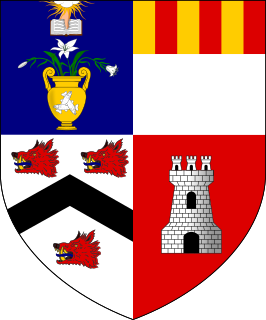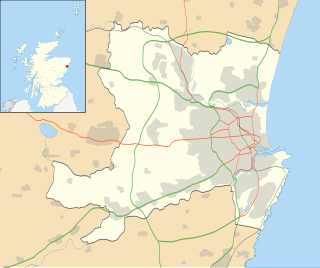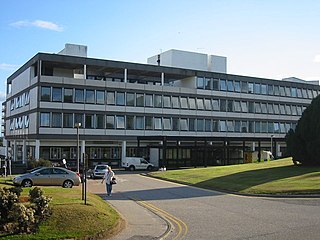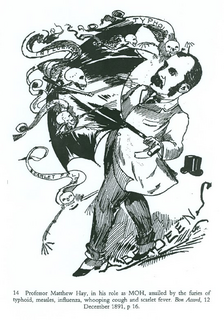
The Suttie Centre is a purpose-built training centre on the Foresterhill hospital campus in Aberdeen.

The Suttie Centre is a purpose-built training centre on the Foresterhill hospital campus in Aberdeen.
The Suttie Centre for Teaching & Learning in Healthcare is a partnership between the University of Aberdeen and NHS Grampian. Designed by Edinburgh architects Bennetts Associates, the £20 million, five-storey, timber-clad building opened in September 2009. [1] Part of the University of Aberdeen, College of Life Sciences and Medicine, the centre is used for teaching undergraduate and postgraduate students, and a wide range of healthcare staff use it for their continuing professional development. There is public access to displays on medical history. [1]
The centre contains the university Anatomy department, a 220-seat lecture theatre, a simulated ward area and facilities for the ‘volunteer patients’ who support the teaching of clinical skills. [2] Advanced technology includes an IT suite and a range of innovative simulators including the UK’s first ‘sim-baby’. [1] A public cafe and museum area presents the history of medicine in the north-east of Scotland.
A central atrium allows natural light into the heart of the building, which has a 6500 square metre floorspace in total. [3] [4]
The centre is the fulfilment of the vision of Professor Matthew Hay for the Foresterhill Health Campus, a joint site for healthcare. [5] In 1900 he identified Foresterhill as a suitable location.
Anglia Ruskin University (ARU) is a university in East Anglia, United Kingdom. Its origins are in the Cambridge School of Art, founded by William John Beamont in 1858. It became a university in 1992 and was renamed after John Ruskin in 2005. It is one of the “post-1992 universities”.
The University of Southampton is a public research university in Southampton, England. Southampton is a founding member of the Russell Group of research-intensive universities in the U.K., and ranked in the top 100 universities in the world.

Newcastle University is a UK public research university based in Newcastle upon Tyne, North East England. It has overseas campuses in Singapore and Malaysia. The university is a red brick university and a member of the Russell Group, an association of research-intensive UK universities.

The University of Aberdeen is a public research university in Aberdeen, Scotland. It is an ancient university founded in 1495 when William Elphinstone, Bishop of Aberdeen and Chancellor of Scotland, petitioned Pope Alexander VI on behalf of James IV, King of Scots to establish King's College, making it Scotland's third-oldest university and the fifth-oldest in the English-speaking world. Aberdeen is consistently ranked among the top 160 universities in the world and is ranked within the top 20 universities in the United Kingdom according to The Guardian, The Times and The Sunday Times.

The University of Sheffield is a public research university in Sheffield, South Yorkshire, England. Its history traces back to the foundation of Sheffield Medical School in 1828, Firth College in 1879 and Sheffield Technical School in 1884. University College of Sheffield was subsequently formed by the amalgamation of the three institutions in 1897 and was granted a royal charter as University of Sheffield in 1905 by King Edward VII.

Robert Gordon University, commonly called RGU, is a public university in the city of Aberdeen, Scotland. It became a university in 1992, and originated from an educational institution founded in the 18th century by Robert Gordon, a prosperous Aberdeen merchant, and various institutions which provided adult education and technical education in the 19th and early 20th centuries. It is one of two universities in the city. RGU is a campus university and its single campus in Aberdeen is at Garthdee, in the south-west of the city.

Oxford Brookes University is a public research university in Oxford, England. It is a new university, having received university status through the Further and Higher Education Act 1992. It can trace its origins to 1865, when it was founded as the Oxford School of Art. The university was named after its first principal, John Henry Brookes, who played a major role in the development of the institution.

Marischal College is a large granite building on Broad Street in the centre of Aberdeen in north-east Scotland, and since 2011 has acted as the headquarters of Aberdeen City Council. However, the building was constructed for and is on long-term lease from the University of Aberdeen, which still uses parts of the building to house a museum. Today, it provides corporate office space and public access to council services, adjacent to the Town House, the city's historic seat of local government. Many Aberdonians consider Marischal College to be an icon of the "Granite City" and to symbolise the zenith of Aberdeen's granite-working industry.

The University of Bedfordshire is a public research university with campuses in Bedfordshire and Buckinghamshire, England. The University has roots from 1882, however, it gained university status in 1993 as the University of Luton. The University changed its name to the University of Bedfordshire in 2006 by the approval of the Privy Council, following the merger of the University of Luton and the Bedford campus of De Montfort University.

Foresterhill is an area in the city of Aberdeen, Scotland. It is the site of the city's main hospitals, as well as the medical school and medical science departments of the University of Aberdeen. It is the largest hospital complex in Europe.

Aberdeen Royal Infirmary (ARI) is the largest hospital in the Grampian area, located on the Foresterhill site in Aberdeen, Scotland. ARI is a teaching hospital with around 900 inpatient beds, offering tertiary care for a population of over 600,000 across the North of Scotland. It offers all medical specialities with the exception of heart and liver transplants. It is managed by NHS Grampian.

NHS Grampian is an NHS board which forms one of the fourteen regional health boards of NHS Scotland. It is responsible for proving health and social care services to a population of over 500,000 people living in Aberdeen, Aberdeenshire and Moray.

Aberdeen Maternity Hospital (AMH) is a specialist maternity hospital in Aberdeen, Scotland. Between 4,000 and 5,000 babies are born at AMH each year. The hospital is located in the Foresterhill area of Aberdeen and serves the region of Grampian as well as the islands of Shetland and Orkney. It is managed by NHS Grampian.

Woolmanhill Hospital was a health facility in the city centre of Aberdeen, Scotland. It was the original Aberdeen Royal Infirmary, a complex which opened in 1749 and was replaced by new facility at Foresterhill in 1936. After services transferred to Aberdeen Community Health and Care Village, the Foresterhill site and Woodend Hospital, the Woolmanhill Hospital closed in April 2017. The complex is centred on a neo-classical main block with later nineteenth century buildings to the rear. Unusually, it has remained largely complete, with later building having taken place at Foresterhill. It was managed by NHS Grampian.
Aberdeen University School of Medicine, Medical Sciences & Nutrition contains the Medical School and Dental School at the University of Aberdeen in Scotland. It also provides training and carries out research in medical sciences, nutrition, public health, dentistry, health sciences, physician associate studies at BSc, MSc, and PhD levels. The current school was formed from the merger of the former School of Medicine & Dentistry, School of Medical Sciences, and the Rowett Institute of Nutrition.

Matthew Hay (1855–1932) was a Scottish doctor and champion of Public Health. He was appointed Medical Officer of Health for the City of Aberdeen in 1888, a post he held until 1923. He was also Professor of Forensic Medicine at the University of Aberdeen.

The Scott Sutherland School of Architecture and Built Environment, Robert Gordon University, is located at the university's Garthdee campus in Aberdeen, Scotland.

Roxburghe House is a specialist palliative care unit which is situated near Foresterhill, Aberdeen, Scotland. It is managed by NHS Grampian.
The University of Nottingham operates from four campuses in Nottinghamshire and from two overseas campuses, one in Ningbo, China and the other in Semenyih, Malaysia. The Ningbo campus was officially opened on 23 February 2005 by the then British Deputy Prime Minister, John Prescott, in the presence of Chinese education minister Zhou Ji and State Counsellor Chen Zhili. The Malaysia campus was the first purpose-built UK university campus in a foreign country and was officially opened by Najib Tun Razak on 26 September 2005. Najib Tun Razak, as well as being a Nottingham alumnus, was Deputy Prime Minister of Malaysia at the time and has since become Prime Minister of Malaysia.

The Sir Duncan Rice Library is the main academic library for the University of Aberdeen. It was designed by Schmidt Hammer Lassen Architects and completed in 2011. It is named after Duncan Rice, a previous Principal of the university. The cube-shaped building can be seen prominently from the entire campus and much of the city. It is a seven-storey tower, clad in zebra-like jagged stripes of white and clear glass. The building has a floorspace of 15,500 square metres. It houses several of the University's historic collections, including more than a quarter of a million ancient and priceless books and manuscripts that have been collected over five centuries since the University's foundation. There is also public exhibition space. The library replaced the smaller Queen Mother Library as the university's main library.